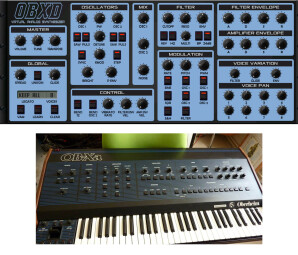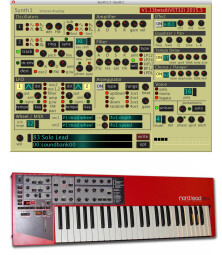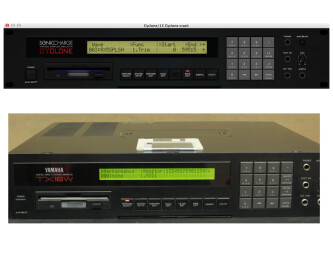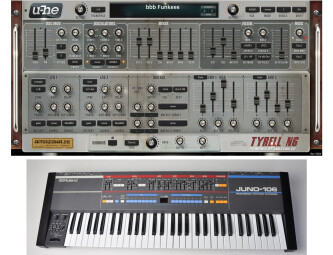You often hear that a $1,000 laptop today has the power of a billion dollars worth of computer equipment from 50 years ago. Likewise, the equivalent of thousands of dollars of vintage synthesizer gear often exists in the form of a low-cost or even freeware plug-in. To say it’s a beautiful time to be a computer musician would be an understatement.
To help you enjoy this cornucopia of synthesizer riches, we present a list of five quality virtual synth plug-ins (Mac/PC) that capture the spirit of influential early music gear, and which will cost you precisely zilch. Enjoy.
DaTsounds OBXD (AU/VST)
Oberheim is getting into the analog synth revival with a new version of the Two Voice, but back in the analog synth heyday, the Oberheim OB-Xa and OB-8 polyphonic analog synths contributed to many of the seminal synth bands of the time, such as Depeche Mode, Thompson Twins, Simple Minds, Styx, Gary Numan, New Order, as well as many other electronic acts from the ‘90s to the present.
The free OBXD plug-in does its best to recreate the rich pads and fat, punchy basses of those classic OB machines. It does not exactly copy them, but it’s straightforward analog-style interface adds new elements like a continuous blendable multimode filter and optional velocity control over the filter envelope and amp envelope amounts. It doesn’t have internal preset management, but you can save instances of it through your DAW as .fxb or .aupreset files. What more do you want? It’s free! This is a must-download.
This chordal sample of the OBXD shows off the warmth of the plug-in’s filter.

Digital Suburban Dexed (AU/VST)
|
Dexed brings back the 1980s with its authentic DX7/TX7 sounds
|
The Yamaha DX7 ushered in the transition from analog to digital synths in the '80s, but it did so at a cost. FM (frequency modulation) synthesis was so different, and the DX7 was so intractably menu-based that it stalled entire careers — for example Kraftwerk’s — while people tried to figure it out. Yet everybody, from The Cure to Phil Collins to the Beastie Boys, used the DX7, to the point that it has imprinted itself on popular music.
These days, we can penetrate the mysteries of FM synthesis much more readily through graphic interfaces, and Dexed does that with six operator modules, each with plenty of knobs and displays for the envelope generator level and rate and a total of 144 DAW automatable parameters. You can use it as a DX7/TX7 patch editor or load/save DX7/TX7 programs.
The Dexed EchoEcho3 preset showcases a representative FM sound in this audio clip.

Daichi Laboratory Synth1 (AU/VST)
|
|
The Clavia Nord Lead was a revelation in digital analog modeling synthesis, and the Nord Lead Nord 2 (1997) made some crucial adjustments to the filter, ring modulator, etc. to make it a classic used by all the techno/big beat royalty of the '90s, including The Crystal Method, The Prodigy, Autechre, Fatboy Slim, Underworld and many others like Dr. Dre and Nine Inch Nails.
The largely unheralded Synth1 by Ichiro Toda’s Daichi Laboratory models itself after the Nord Lead 2 and includes all the essential features, such as a host-synchronized delay and arpeggiator. It also comes with 128 presets that authentically exhibit a ‘90s vibe, but you can exercise your patch-building muscles to create some pretty beefy modern sounds. An important modern feature like the Unison mode lets you build some really thick lead sounds.
This squelchy audio clip demonstrates the Synth1 Solo Lead preset in Unison mode.

Sonic Charge Cyclone (AU/VST)
The original Yamaha TX16W sampler from 1987 thrilled a lot of people with its unique
12-bit sound aided by 17 filter types. However, it probably frustrated even more people with its dense two-line-display user interface and painfully slow operation. In 1993, Magnus Lidström wrote an alternative operating system for the sampler called Typhoon, which improved matters quite a bit. Lidström went on to start the successful plug-in company Sonic Charge, and in 2013, to celebrate the 20th anniversary of Typhoon, he released the free plug-in Cyclone, a faithful plug-in version of the TX16W, with the same signature sound and same Typhoon OS.
Cyclone emulates all the important hardware of the original TX16W, including the 68000 processor, the DACs and proprietary Yamaha DSPs. So the sound is spot-on, but operating a vintage sampler interface with a mouse is time-consuming and also quite unfamiliar to younger people who have grown up in the plug-in era.
So for those who may not need the authentic vintage experience, there is Cwitec TX16Wx, an excellent freeware sampler that used to be more of an updated TX16W in plug-in form. However, over the years it has evolved into a full-featured sampler plug-in based on a number of hardware samplers, while adding the advantages of a modern software interface. Highlights include a full built-in sample editor with sample recording, modulation matrix, graphic keyboard map editor, automation, and tons of audio format support, such as WAV, AIFF, SFZ, SoundFont 2, Ogg, FLAC, REX, Akai, Typhoon and Yamaha OS.
This Cyclone audio clip uses the Yamaha RX5 vintage drum machine (1986) sounds that you can get (plus a lot more sounds) from a link on the Sonic Charge site when you download the plug-in.

U-He Tyrell Nexus 6 (VST/VST3)
Roland’s Juno-106 (1984) was one of the first MIDI-controlled analog polysynths. It featured basically the same sound as the previous Juno-60 but with 128 patch memories and extensive MIDI control. It became a fixture of '80s and '90s dance music from artists such as 808 State, Leftfield, Moby, Josh Wink, Pet Shop Boys, Erasure, Chemical Brothers and many others.
U-he’s Tyrell Nexus 6 freeware plug-in not only sounds remarkably like the Juno series of vintage synths, but it’s also one of the best plug-ins for learning pro-level analog synth programming with a free plug-in. Tyrell N6 has a simple, hardware-style interface that can lead you to the panoply of analog synth sounds: deep, wide basses; thick, gorgeous pads; cutting leads and diverse special effects.
The “bbb Funkee” bass sound harkens back to the analog '80s.






